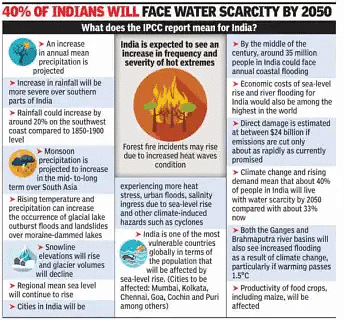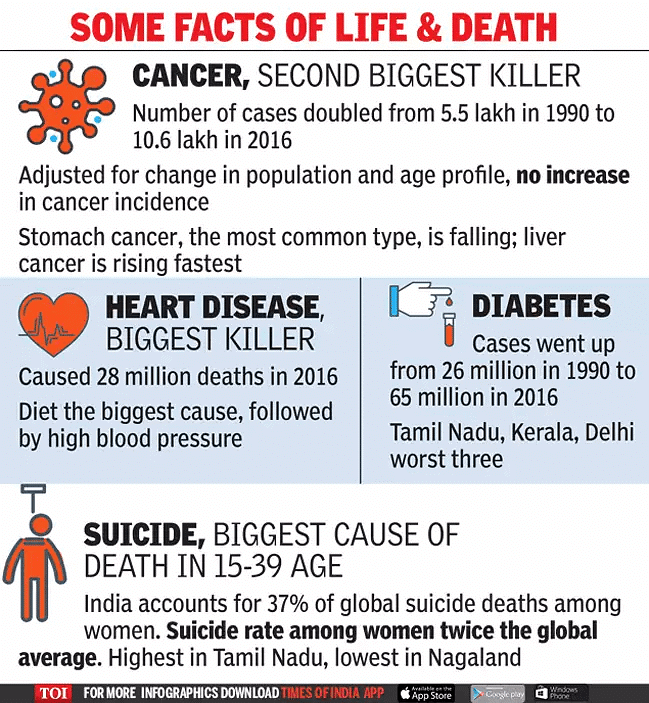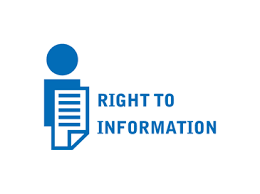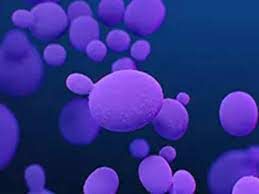UPSC Daily Current Affairs- 22nd March 2023 | Current Affairs & Hindu Analysis: Daily, Weekly & Monthly PDF Download
| Table of contents |

|
| GS-I |

|
| GS-II |

|
| Insurance Coverage and Out-of-Pocket Expenses |

|
| State-wise Variation in Cancer Treatment Expenditure |

|
| GS-III |

|
GS-I
Key takeaway of the IPCC Synthesis Report
Why in News?
The IPCC Synthesis Report warns that the world is on track to breach the 1.5-degree Celsius global warming limit by the 2030s, which would cause irrevocable damage to the planet’s ecosystem and severely impact humans and other living beings.
What is IPCC Synthesis Report?
- The IPCC Synthesis Report is a summary report produced by the Intergovernmental Panel on Climate Change (IPCC) that presents key findings and policy recommendations from the group’s previous assessment reports.
- It aims to provide policymakers with a concise overview of the current state of knowledge on climate change, its impacts, and options for mitigation and adaptation.
- The Synthesis Report is released at the end of each assessment cycle, which typically takes six to seven years, and is approved by representatives from the IPCC’s member governments.
Key highlights of the synthesis report
- Climate extremes on rise: Due to the current global warming levels, almost every region across the planet is already experiencing climate extremes, an uptick in deaths due to heatwaves, reduced food and water security, and damage to ecosystems, causing mass extinction of species on land and in the ocean.
- High vulnerability: More than three billion people live in areas that are “highly vulnerable” to climate change.
- Boost up climate finance: The largest gaps in climate finance are in the developing world, but so too are the largest opportunities.
Key concerns raised
The report highlights the urgent need for-
- Limiting the use of fossil fuels
- Increasing finance to climate investments
- Expanding the clean energy infrastructure,
- Reducing nitrogen pollution from agriculture, curtail food waste, and
- Adopting measures to make it easier for people to lead low-carbon lifestyles
Conclusion
The report adds that there is still a chance to avert this mass-scale destruction, but it would require an enormous global effort to slash greenhouse gas emissions in half by 2030 and completely phase them out by 2050.
Source: Indian Express
GS-II
Rising Cancer Cases in India And Economic Burden
Why in News?
Cancer cases in India are predicted to cross the 15 lakh mark by 2025, highlighting concerns about the economic burden of expensive cancer treatments and the accessibility of affordable healthcare for patients.
Cancer
- Cancer is a group of diseases that arise when cells in the body begin to grow and divide uncontrollably, leading to the formation of tumors.
- Normally, cells in the body grow, divide, and die in an orderly fashion, but in cancer, this process goes awry, leading to the accumulation of abnormal cells that can form a mass or tumor.
- There are many different types of cancer, which can affect any part of the body. Some cancers, such as leukemia, do not form tumors but still involve the uncontrolled growth of abnormal cells.
- Symptoms of cancer can vary depending on the type and location of the cancer, but common signs include unexplained weight loss, fatigue, pain, and changes in the skin or the appearance of a lump or mass.
Economic Burden of Cancer Treatment
- Inaccessible and Increasing Costs:
- The average medical expenditure per hospitalization case for cancer treatment was ₹68,259 in urban areas, according to the NSS 2017-18 report.
- A Parliamentary Standing Committee report expressed concern about the inaccessible and increasing cost of cancer treatment.
- Regulatory Challenges:
- While anti-cancer medicine costs can be regulated, the cost of radiotherapy cannot, as it has not been declared an essential service.
- Insurance Coverage and Out-of-Pocket Expenses.
- Impact on Patients:
- Cancer often strikes around the retirement age, leading to mounting debt burdens.
- The average hospital stay for 14.1% of cancer patients is more than 30 days, further increasing bills.
Insurance Coverage and Out-of-Pocket Expenses
- Poor Insurance Penetration: More than 80% of hospital bills are paid out of pocket, as per the NSS 2017-18 report.
- Ayushman Bharat Limitations: The Committee observed that the Ayushman Bharat insurance scheme launched in 2018 does not cover entire prescriptions, latest cancer therapies, or many diagnostic tests.
- State-Specific Insurance Schemes: The Committee suggested a convergence of State and Central schemes, as some State-specific insurance schemes have been highly beneficial.
State-wise Variation in Cancer Treatment Expenditure
- State-wise average medical expenditure per hospitalization case for cancer treatment in government hospitals varies, with the lowest in Tamil Nadu and Telangana, and the highest in northern and north-eastern India.
Facts for Prelims: CAR T-cell therapy
- Unlike chemotherapy or immunotherapy, which require mass-produced injectable or oral medication, CAR T-cell therapies use a patient’s own cells.
- The treatment involves modifying a patient’s own T-cells, which are a type of immune cell, in a laboratory to target and attack cancer cells.
- CAR stands for chimeric antigen receptor, which refers to the genetically engineered receptor that is added to the patient’s T-cells.
- The patient’s T-cells are collected and genetically modified in a laboratory to express the CAR.
- The modified T-cells are then infused back into the patient’s body, where they can seek out and destroy cancer cells that express the antigen targeted by the CAR.
- The cells are even more specific than targeted agents and directly activate the patient’s immune system against cancer, making the treatment more clinically effective.
- This is why they’re called living drugs.
- CAR T-cell therapy has shown promising results in treating certain types of blood cancers, including leukemia and lymphoma.
Conclusion
The rising number of cancer cases in India underscores the need to address the economic burden of expensive cancer treatments and improve the accessibility of affordable healthcare for patients. Converging State and Central insurance schemes, expanding insurance coverage, and exploring ways to regulate treatment costs are essential steps to ensure that patients can access life-saving treatments without facing insurmountable financial challenges.
Source: The Hindu
What is the International Telecommunication Union (ITU)?

Why in News?
Prime Minister will inaugurate the new International Telecommunication Union (ITU) Area office and Innovation Centre at a programme in Delhis Vigyan Bhawan.
About International Telecommunication Union (ITU):
- It is the United Nations specialized agency for information and communication technologies.
- It is an intergovernmental organization that coordinates between governments and private sector bodies with respect to global telecommunication and information communication technology (ICT) services.
- It was established in 1865 as International Telegraph Union.
- In 1947 the ITU became a specialized agency of the United Nations.
- Headquarters: Geneva, Switzerland.
- Membership: It has a membership of 193 countries and nearly 800 private sector entities and academic institutions.
- Functions:
- allocate global radio spectrum and satellite orbits;
- coordination and setting of technical standards related to telecommunication/ICT;
- strive to improve access to ICTs in underserved communities worldwide;
- India and ITU: India has been an active member of the ITU since 1869 and has been a regular member of the ITU Council since 1952.
ITU Area office and Innovation Centre:
- The Area Office, which is fully funded by India, is located on the second floor of the Centre for Development of Telematics (C-DoT) building at Mehrauli in New Delhi.
- It will serve India, Nepal, Bhutan, Bangladesh, Sri Lanka, Maldives, Afghanistan, and Iran.
- It will enhance coordination among nations and foster mutually beneficial economic cooperation in the region.
Source: DownToEarth
SC asks govt. for data on Death by Hanging
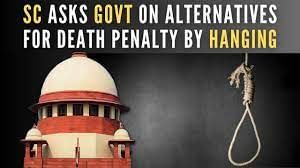
Why in News?
The Supreme Court has asked the Centre to provide data which may point to a more dignified, less painful and socially acceptable method of executing prisoners other than death by hanging.
Central idea
- The Supreme Court is hearing a petition challenging the constitutionality of death by hanging as a mode of execution.
- The petition argued that there is a need to evolve a “humane, quick and decent alternative” to hanging, which he termed as “cruel and barbarous” compared to lethal injection used in the United States.
Quest for painless execution
- Justice Narasimha noted that there was literature suggesting that “hanging is closest to painless”.
- In 2018, the Centre filed an affidavit supporting death by hanging and stated that it had found the method of firing squads and lethal injections as “barbaric, inhuman and cruel”.
- The government traced statistics of “botched-up” administration of lethal injections to condemned prisoners in the United States for 110 years to prove its point.
Status of death penalty in India
- Section 354 (5) of the Code of Criminal Procedure mandates that a person sentenced to death shall “be hanged by the neck till he is dead”.
- In India, The Air Force Act, 1950, The Army Act 1950, and The Navy Act 1957 say that execution has to be carried out either by hanging by the neck until death or by being shot to death.
Why in news now?
- The court clarified that it was not questioning the constitutionality of the death penalty, which was well-settled in Deena versus Union of India judgment and the Bachan Singh case reported in 1980.
- The government argued that the mode of execution is a “matter of legislative policy” and the death penalty is awarded only in the rarest of rare cases, with only three executions between 2012 and 2015.
Debate over Death Penalty
Arguments in favor:
- Forfeiture of life: Supporters of the death penalty believe that those who commit murder, because they have taken the life of another, have forfeited their own right to life.
- Moral indignation of the victim: It is a just form of retribution, expressing and reinforcing the moral indignation not only of the victim’s relatives but of law-abiding citizens in general.
- Highest form of Justice: For heinous crimes such as the Nirbhaya Gangrape Case, no other punishment could have deterred the will of the convicts.
- Deterrent against crime: Capital punishment is often justified with the argument that by executing convicted murderers, we will deter would-be murderers from killing people.
- Proportional punishment: The guilty people deserve to be punished in proportion to the severity of their crime.
- Prevailing lawlessness: The crimes we are now witnessing cannot be addressed by simple punishments. We are seeing horrific attacks on women, young girls, minority communities and Dalits etc.
- Prevention of crime is non-existent: Despite of stringent regulations, it is certainly visible that some crimes can never be prevented in our society.
Arguments against:
- Eye for an eye: Reformative justice is more productive, that innocent people are often killed in the search for retribution, and that “an eye for an eye makes the whole world blind.
- Deterrence is a myth: Death penalty is not a deterrent to capital crimes state that there is no evidence to support the claim that the penalty is a deterrent.
- Political tool of suppression: The authorities in some countries, for example Iran and Sudan, use the death penalty to punish political opponents.
- Reverence for life’ principle: Death penalty is an immoral punishment since humans should not kill other humans, no matter the reasons, because killing is killing.
- Stigma against killing: With the introduction of lethal injection as execution method, medical professionals participate in executions. Many professionals have now refused to administer such deaths.
- Skewed justice systems: In many cases recorded by Amnesty International, people were executed after being convicted in grossly unfair trials, on the basis of torture-tainted evidence and with inadequate legal representation.
- Discriminatory nature: The weight of the death penalty is disproportionally carried by those with less advantaged socio-economic backgrounds or belonging to a racial, ethnic or religious minority.
- Penalizing the innocents: The risk of executing the innocent precludes the use of the death penalty. Our colonial history has witnessed many such executions.
Other issues with such executions
Socio-Economic Factors
- The recent statistics shows that the death row prisoners in India are more from the backward classes of the society.
- The death row prisoners belong to backward classes and religious minorities and the majority of convicts’ families are living in adjunct poverty.
- These people who are backward both in economic and social respects, are not in a position to here expensive lawyers and get proper representation in the Court.
Delayed Execution
- The law provides for a long process before the execution of the convicts actually takes place.
- The unexplained delay in execution can be a ground for commutation of death penalty, and an inmate, his or her kin, or even a public-spirited citizen could file a writ petition seeking such commutation.
- Their trials are often cruelly forced to endure long periods of uncertainty about their fate.
Way forward: Law Commission recommendations on death penalty
The Law Commission of India in its 262nd Report (August 2015) recommended that:
- Death penalty be abolished for all crimes other than terrorism-related offences and waging war.
- Measures such as police reforms, witness protection scheme and victim compensation scheme should be taken up expeditiously by the government.
- It felt that time has come for India to move towards abolition of the death penalty. However the concern is often raised that abolition of death penalty for terrorism-related offences and waging war, will affect national security.
Source: The Hindu
What is the Right to Information (RTI) Act, 2005?
The Supreme Court recently directed all high courts to set up RTI websites within three months.
About Right to Information (RTI) Act, 2005:
- It is a law enacted by the Parliament of India "to provide for setting out the practical regime of right to information for citizens.
- The Right to Information is derived from our fundamental right of Expression under Article 19 of the Constitution of India.
- The Act applies to all States and Union Territories of India.
- Under the provisions of the Act, any citizen may request information from a "public authority" (a body of Government or "instrumentality of State") by making an application in writing or through electronic means.
- The information seeker is not required to give reasons for seeking information.
- Time Period for Supply of Information:
- In the normal course, information to an applicant shall be supplied within 30 days from the receipt of the application by the public authority.
- If the information sought concerns the life or liberty of a person, it should be supplied within 48 hours.
- Public Information Officer (PIO): Every public authority shall designate some of its officers as They are responsible for giving information to a person who seeks information under the RTI Act.
- The Act also requires every public authority to computerize their records for wide dissemination and to proactively publish certain categories of information so that the citizens need minimum recourse to request information formally.
- Exemptions:
- It also contains several exemptions which enable public authorities to deny requests for information. It ranges from the sovereignty and security of India to trade secrets.
- Section 24 of the act exempts certain security and intelligence organizations from the purview of the act except the information pertaining to the allegations of corruption and human rights violations.
Source: PIB
GS-III
INS Androth

Why in News?
The INS Androth, the second in a series of eight Anti-Submarine Warfare Shallow Water Craft (ASW SWC), was launched recently.
About INS Androth:
- It is an Anti-Submarine Warfare Shallow Water Craft (ASW SWC).
- It is built by Garden Reach Shipbuilders and Engineers (GRSE) in Kolkata for the Indian Navy.
- Primary Role: To conduct anti-submarine operations in coastal waters, low-intensity maritime operations, and mine-laying operations.
- It is also capable of full-scale sub-surface surveillance of coastal waters and various surface platforms and coordinated ASW operations with aircraft.
- Features:
- It is about 77.6 meters long and 10.5 meters wide and requires a draught of only 2.7 meters.
- It is propelled by three diesel-driven water jets.
- It can attain a maximum speed of 25 knots.
- It carries lightweight torpedoes, ASW rockets and mines, a close-in weapon system (with a 30 mm gun), and 16.7 mm stabilized remote-controlled guns.
- It will be fitted with hull-mounted sonar and a low-frequency variable depth sonar.
Source: The Hindu
What is Candida Auris (C. auris)?
Why in News?
A drug-resistant and potentially deadly fungus ‘Candida Auris’ is spreading rapidly across the United States.
About Candida Auris (C. auris):
- It is a multi-drug resistant fungus that is capable of causing invasive infections in the human body.
- It was first identified in Japan in 2009.
- How is it contracted?
- Most cases of the fungus have been reported in healthcare settings, such as hospitals and nursing homes.
- It is generally thought to be spread through contact with contaminated surfaces or by person-to-person transmission.
- People who are already suffering from other medical conditions, recent hospital stays, and invasive devices are most at risk of contracting the fungus.
- How does the fungus act on the body? There are two ways C. auris can affect the body,
- The fungus can either live on a specific region, such as the skin, rectum, or mouth, in a process called “asymptomatic colonization,” where a patient has no symptoms but can spread it to other people.
- It can enter the bloodstream or wounds, where it can cause severe invasive infections.
- Symptoms:
- Its symptoms are often similar to those of other common diseases and hence diagnosis is difficult.
- The most common symptoms of C.auris include fever and chills that don’t go away after treatment with antibiotics.
- Mortality Rate: It is estimated to be between 30-60%.
- Treatment:
- Most C. auris infections are treatable with antifungal medications called echinocandins.
- However, there has been a rise in cases resistant to the main three classes of antifungals available, making it harder to treat patients.
Source: The Hindu
|
38 videos|5283 docs|1116 tests
|
FAQs on UPSC Daily Current Affairs- 22nd March 2023 - Current Affairs & Hindu Analysis: Daily, Weekly & Monthly
| 1. What are the three stages of the UPSC exam? |  |
| 2. What is the significance of GS-I in the UPSC exam? |  |
| 3. What subjects are included in GS-II of the UPSC exam? |  |
| 4. What topics are covered in GS-III of the UPSC exam? |  |
| 5. How can one prepare effectively for the GS-I, GS-II, and GS-III stages of the UPSC exam? |  |

